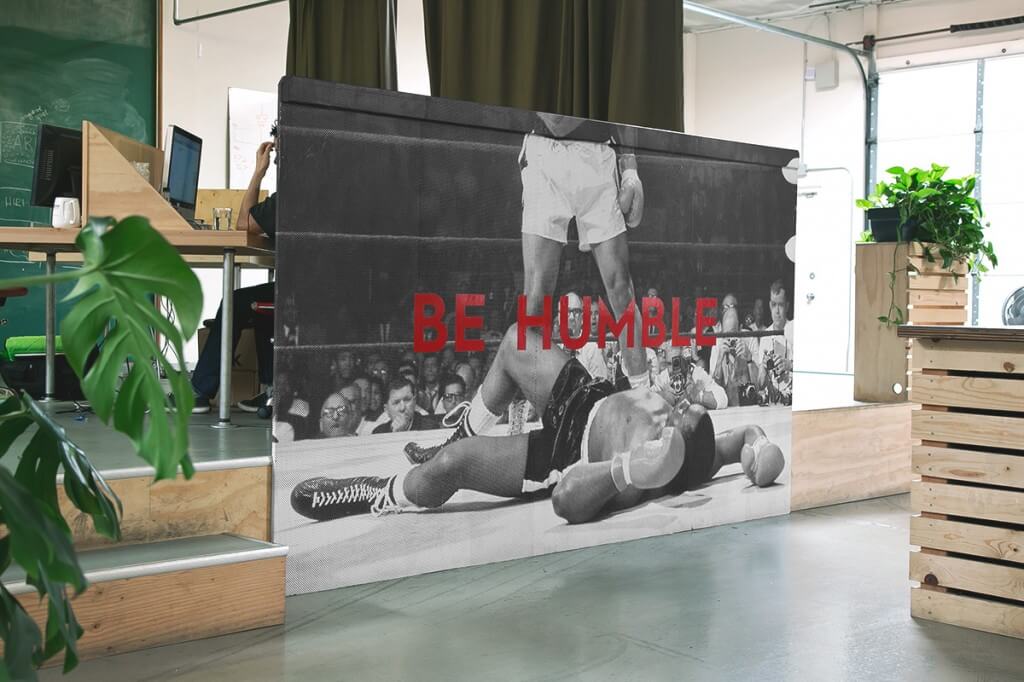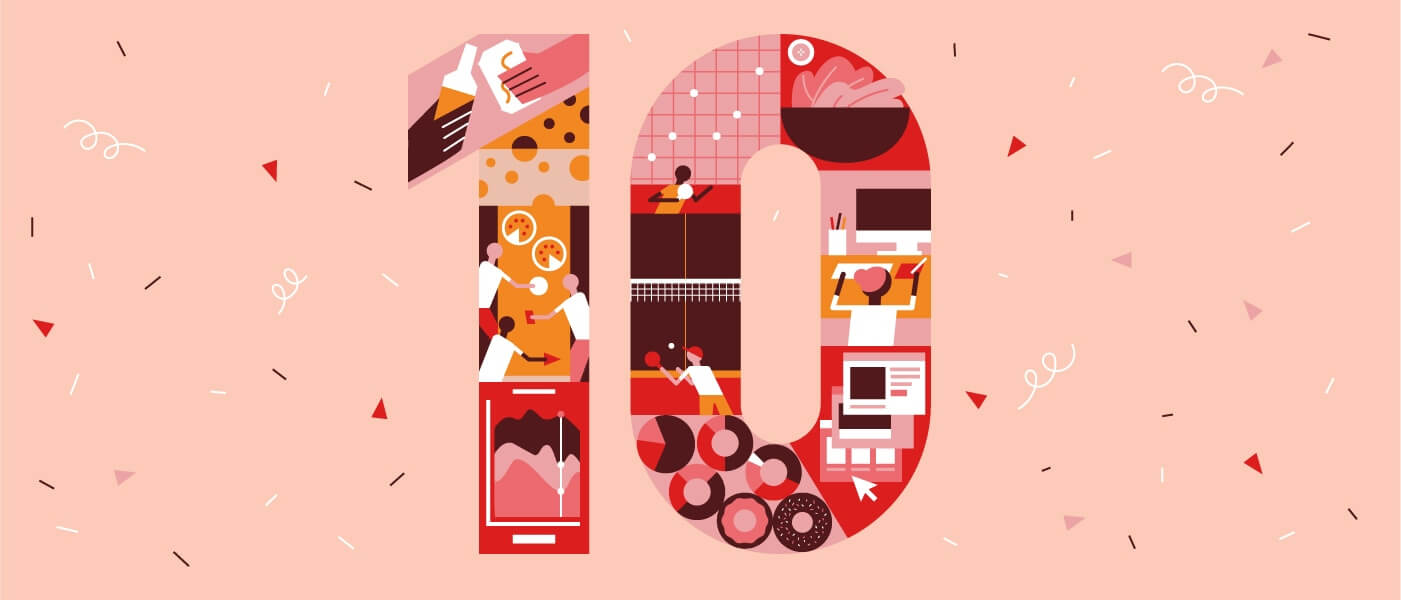Building Column Five has been a hell of a journey over the last 10 years. Our team has grown in every way possible, from exploring new cities to starting new families, and in many ways we’ve grown up together. It’s been exciting. It’s been painful. But above all, it’s been a huge learning experience, both personally and professionally.
We’ve celebrated huge successes, and we’ve suffered failures, frustrations, and mistakes. But we’ve always tried to use our missteps as an opportunity to push ourselves, adapt, learn, and grow. So here we are today: a little wiser, a little grayer (or balder), and plenty grateful for this thing we never even intended to build.
Now that we’re celebrating our first decade in business, we’ve been thinking a lot about how far we’ve come and the lessons we’ve learned along the way.
View this post on Instagram
Truth be told, we wish we didn’t have to learn some of those lessons the hard way, but we know the knowledge we’ve gained will only help us in the long run. We also realize that sharing it might help others avoid the same pitfalls today, or have the courage to take proactive steps tomorrow.
So we’ve decided to take a walk down memory lane and identify the biggest lessons learned from each year we’ve been in business (2009-2019). Some of these lessons are more obvious than we’d like to admit; others blindsided us, but they all taught us something valuable. We hope you find them useful, too.
Lesson 1 (2009): The thing you’re doing might not be what you’re meant to do.
As we’ve detailed in our origin story, Column Five was a happy accident. Jason, Ross, and I actually started out in apparel. We only stumbled into content marketing because we discovered that it was an effective way to promote our clothing brands. As it turned out, we were pretty good at the content part. The selling clothes part? Not so much.
Soon, other brands started asking us to do content for them, and we had a choice to make: explore this new content marketing thing, or stick with our struggling businesses. In 2009 we decided to take a chance and officially become Column Five.
That meant going “legit” with a (somewhat legal) office space and our first few hires. (Ten years later, many of our early hires are still with us, so we must have done something right.) It was a scary time filled with a lot of unknowns—like how to charge for our work or manage more clients—but by being open to the opportunities presented to us and determined to figure it out, we set ourselves up for more success than we ever imagined.
Our early office: part dorm-room, part crash pad.
View this post on Instagram
The takeaway: It took a lot for us all to give up our initial dreams of apparel domination (JK, truthfully we had no idea what we were doing). But we believe in listening to the universe and feeding the things that feed you (that and also because C5 enabled us to start paying our bills somewhat on time). Had we decided not to start C5 because it’s not what we originally set out to do, we would have lost out on so much.
Lesson 2 (2010): Growth is great—but you better be ready for it.
We were fortunate to quickly grow a sizable roster of clients early on. And with an expanding team, we had the bandwidth to take on more projects. But, of course, more clients and more staff equaled more things to figure out. We weren’t totally equipped to deal with our quick growth, so it got a little chaotic with managing people and projects, keeping track of timelines, and trying to use the microwave and toaster simultaneously without short-circuiting the office. (We never did figure that one out.)
We desperately needed the infrastructure to handle our projects without losing our minds, and much of that required finding the right tools and processes for us. There was definitely a lot of trial and error, arguments, frustrations, and inefficiencies. But we did our best to keep communication lines open, focus on what we needed, and collaborate to create systems that worked for everyone.
Our motto since day one.
View this post on Instagram
The takeaway: You can’t expect people to succeed without the support, tools, and even WIFI they need to do their jobs. When frustrations or tensions rise, assume positive intent and focus on solving the problem at hand with the resources you have.
Lesson 3 (2011): Don’t be too humble, or you’ll get left behind.
“Be Humble” is one of our core values, and it serves us well in our relationships with creative partners and with each other. But in the larger marketplace, we were getting outshined by agencies who were louder and flashier.

We were lucky enough to have strong word-of-mouth referrals, but we knew we needed a larger brand presence if we wanted real longevity—and that required us to be more aggressive in marketing ourselves.
That was when we started to eat our own dog food. We’d been helping all sorts of brands tell their stories and claim their stake in the market through content—yet we weren’t doing it much for ourselves. So we decided to change that. We started teaching a class on the visualization of information for Columbia, we wrote the book Infographics: The Power of Visual Storytelling, we contributed to publications like Forbes, and we published our own thought-leadership through our blog.
Collectively, these efforts helped raise our profile and attract some of our most exciting work to date.
The takeaway: Creating content can feel intimidating, but you can always start small and grow from there. For example, we started cross-posting content with Newscred to fill our blog before we were able to produce more content. If you’re not sure where to start with content, here are a few ideas.
Lesson 4 (2012): Your comfort zone will kill you.
Honestly, the first few years of Column Five were exciting but kinda scary. Our word-of-mouth referrals were growing, and we attracted more visibility thanks to our marketing efforts. But that also meant that larger brands were seeking our services, and we weren’t always equipped to deliver them.
We’d become infographic and data visualization experts, and we were damn good at it. But after losing out on a few huge opportunities, we realized we needed to step out of our comfort zone and expand our capabilities.
So, again, we made a fresh push to bring in experts who could create different types of content like video, motion graphics, and interactives. This helped us execute brands’ content strategies at a larger scale and, most importantly, create the highest-quality work—one of our main differentiators.
The takeaway: Don’t ruminate on losses; let them show you where and how you need to grow. Also, if you’re not comfortable with a new skill, experiment on yourself first. Our early forays into motion graphics started with our Power of Data Visualization motion graphic, an educational piece of content that helped us explain why infographics and data visualization (our core services) were so effective.
Lesson 5 (2013): Don’t hurt your team by trying to be a hero.
2013 was the year we upgraded our agency. We moved into a larger office to house our expanded team and became a full-service agency. But it also became clear that we cofounders couldn’t handle it all. From operations and team meetings to after-hours teaching and traveling, we were stretched too thin and struggling to provide the leadership and mentorship our team needed.
We had to check our egos and take a cold, hard look at where we were falling short, what we realistically could and couldn’t do, and what our team really needed across all departments, including IT, HR, Creative Leadership, PR, Sales, Communications, etc.
To help us through this time, we got HR (our awesome VP of People and Culture Tamara Hlava), we promoted key people to management positions so they could better nurture their teams, and we brought in folks with additional knowledge to guide us in places where we had less experience. This required many real, honest conversations about where our strengths lie and ultimately meant we had to let go a little and delegate things to people who could do them better. That required some reshuffling and reshifting, but it made everyone happier in the end.
The takeaway: Trying to keep a firm grip on everything will eventually lead to burnout. Instead, trust people to do their jobs and prioritize the things that matter the most.
Lesson 6 (2014): To grow tall, you need deep roots.
When we started C5, we were three scrappy guys hustling to keep the lights on. But by 2014, we’d become an established agency that was ready to make big moves. We’d found success with our expanded capabilities, and we were ready to stake our claim in new spaces. Thus, we made a few huge moves: We opened our second office in NY, launched our sister software company Visage, launched a new site, and rebranded.
However, as we invested in these new ventures, we needed to revisit our core beliefs to make sure we were growing our brand in the right ways. To do this, us cofounders took a weekend away for a sort-of C5 vision quest (totally legal, monitored by a coach) to define our brand heart (purpose/vision, mission, and values).
This helped us identify and articulate who we are and why we do this work, which helped realign ourselves and reinvigorate our team in anticipation of these big moves.
The takeaway: Your brand heart is crucial to maintain your sanity. These core values function as your north star, helping you make important decisions in times of confusion or uncertainty—especially important if you’re making big changes. If you haven’t articulated your purpose/vision, mission, and values before, try our guide to building a brand strategy to do it successfully.
Lesson 7 (2015): Good business is really about good relationships.
As we continued to expand, we faced two problems:
- We needed to figure out how to keep our internal team connected with offices on two coasts.
- We were struggling to break a familiar pattern with clients. They’d hire us to execute one-offs or a series of projects, but we weren’t able to help them level-up or tell their brand story as effectively, because we were only working with them at a project level.
To address the issues we were facing internally and externally, we focused on cultivating relationships at every level—between our own teams, our clients, and our branded properties. Focusing on everything through the lens of our brand ecosystem helped us close cultural gaps, establish strategy-level relationships with partners, and learn to work together more efficiently.
The takeaway: Oftentimes little problems are symptomatic of larger, company-wide issues. For us, focusing on relationships helped us reframe our challenges and find a throughline through all our work.
Lesson 8 (2016): Be bold, and it will pay off.
It took us a ton of time, work, and sweat to build C5. We’d expanded (and moved offices again), and now we felt it was time to go for the gold: to become the go-to partner to help brands tell their best stories. This meant focusing on strategy-level work.
In a changing landscape, we wanted to push our partners to grow and take more risks. But first, we needed to prove that they could and should trust our expertise—because we’d succeeded ourselves.
This meant we had to take a look at how we ourselves think about our own brand and content strategy. Yes, we’d created content. Yes, we’d won some awards. Yes, we’d developed relationships. But we’d never really prioritized our own brand.
That changed in 2016 when we decided to revamp our content strategy. We re-examined our processes, doubled down on content, and took more risks than ever. The result? We increased our leads 78% in the first 6 months alone.
The takeaway: We didn’t just tweak our content strategy; we rebuilt it entirely. This required a lot of honest conversations, as well as the freedom to try new things, test new processes, and come up with new ideas. By not clinging to egos or the way things had always been done, we did more with less—proof it’s worth it to take risks.
Lesson 9 (2017): Try to fail better.
It’s exciting to find success in a venture, but it’s also easy to shift into autopilot once you do. Buoyed by our initial content strategy success, we knew we still had a lot more to learn about brand building. Thus, we focused on refining our brand strategy, working more efficiently, and maximizing our results.
This hasn’t always been an easy process for our team. We’ve disagreed and challenged each other, but working through these details has helped us solidify our philosophy and improve our skills—something that benefits both ourselves and our partners.
View this post on Instagram
The takeaway: Just because you find success doesn’t mean you’re done learning. There are always ways to improve, tweak, refine, and experiment—it just takes a team commitment to up your game.
Lesson 10 (2018): It’s OK to do less, but better.
Sometimes when you’re so focused on growing your brand, you forget how difficult it is to maintain. In our 10th year, we found ourselves overextended again. (Sometimes it takes a while to learn your lessons.) We were supporting our sister software company Visage, working from our largest HQ to date, running a separate publication, and trying to keep everything aligned. It was too much.
In short, we were ready to simplify. That meant taking a step back and reevaluating what we’re really trying to do here, how we want to run our company, and what we want our future to look like. So we made some tough decisions. We shuttered our long-standing publication Visual News, bought Visage back from our investors, and simplified our office space.
This helped us streamline our work, refocus our efforts, and focus on what matters most to us.
Read more about why we decided to move into our simple, clean new office space.
View this post on Instagram
The takeaway: It’s never easy to say goodbye to something you’ve worked on for a long time. But sometimes it’s important to take stock of where your energy is going and whether or not what you’re doing is really serving you. It’s not about taking a step backwards. It’s about taking a step toward the future you want.
What We’re Focusing On Now
Probably the biggest lesson we’ve learned is that we’re not done learning. As we enter our next decade, we’re striving for our goals but continuing our transformation. That means peeling away the unnecessary and ineffective parts of our work, and uncovering what is essential, true, and impactful. We’re approaching everything with intention, aiming to focus on what matters most so that we can do the work we enjoy doing and set ourselves up to last for the long run.
It’s only in hindsight that we’ll see where we’ve failed or succeeded, but we’re looking forward to the future, more successes to celebrate, and the work we’ll do with our amazing team and partners for many years to come.
Best,
C3 (Josh, Jason, and Ross)





Thank you for sharing your biggest lesson, I’m learning 🙂 Love to quote what you’ve said Josh
“When frustrations or tensions rise, assume positive intent and focus on solving the problem at hand with the resources you have”. – C5
Can I share it and other takeaways? Thanks in advance 🙂